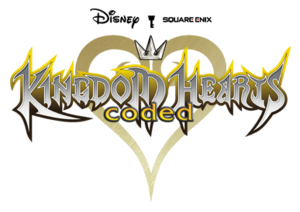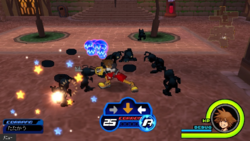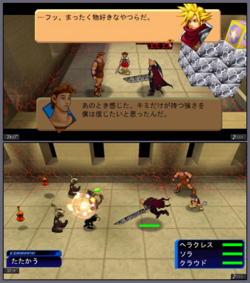Kingdom Hearts coded
| Kingdom Hearts coded | |
|---|---|

| |
| キングダムハーツ コーデッド Kingudamu Hātsu kōdeddo | |
| Developer(s) | Square Enix |
| Publisher(s) | Square Enix |
| Release date(s) | |
| Genre | Console role-playing game |
| Game modes | Single player |
| Ratings | ESRB:N/A |
| Platform(s) | Mobile phone |
Kingdom Hearts coded is the fifth game in the Kingdom Hearts series, taking place just before the epilogue of Kingdom Hearts II. It was released in eight episodes from 2009 to 2010 on the Docomo PRIME Series mobile phones via the Kingdom Hearts Mobile service. As of April 20, 2013, the app is no longer available for download and the website is no longer accessible.
The title was only available in Japan. However, a remake, released in Japan, North America and Europe, was developed for the Nintendo DS,[1] under the title of Kingdom Hearts Re:coded.
There are two special demo episodes for Kingdom Hearts coded, the first of which came pre-installed on the P-01A. Titled Olympus Coliseum -Side Episode-, it features a unique story that was not included in Kingdom Hearts Re:coded. The second demo episode, Traverse Town -SPECIAL EDIT VERSION-, was a simply a preview of the Traverse Town level.
Development[edit]
Tetsuya Nomura mentioned a desire to develop a Kingdom Hearts spin-off title in mid-2007. He specifically wanted to create a title for mobile devices with slightly different gameplay to the mainline entries. Nomura was initially met with resistance, with Hajime Tabata considering the idea "terrible," but acknowledged the concept had potential and greenlit the project anyway. Nomura wanted the game to be like a playground for fans. While initially intended to be a non-canon entry with a floating storyline, the game being developed concurrently with Kingdom Hearts Birth by Sleep and Kingdom Hearts 358/2 Days caused the game to eventually be canonized with a definite place on the timeline. Gameplay was a mixture of 2D and 3D to work better on mobile devices.
The game was very ambitious for a mobile game at the time, being designed for speculative devices that did not exist yet. It did not push boundaries as hard as other Square Enix developed mobile games like Final Fantasy Agito, as the company wanted to publish this game internationally where the mobile market was not as sophisticated as the market in Japan. Examples include the ability for players to wirelessly communicate between each other and the canceled wide screen support.
This game was officially revealed alongside Birth by Sleep and 358/2 Days on September 20, 2007 at the Tokyo Game Show behind closed doors. New trailers debuted at Jump Festa in December 2007 and the DKΣ3713 Private party in August 2008, as well as demos and more new trailers debuted at Playable demonstrations, as well as new trailers, were available at the next Tokyo Game Show in October 2008 and the next Jump Festa in December 2008.
The pre-install demo episode released on November 8, 2008 in Japan on the Docomo PRIME Series "P-01A" mobile phone. The first full episode was released on June 3, 2009, with seven more episodes releasing monthly until January 28, 2010. The international release was quietly canceled due to mobile technology not improving at the rate it needed to for international players to feasibly play the game at the time. This game was an experiment into a subscription-based business model, as all episodes were included in Kingdom Hearts Mobile. All episodes were taken down on April 30, 2013 and are currently unavailable, though the game lives on with Kingdom Hearts Re:coded.
| Episode | Release Date |
|---|---|
| Pre-Install Demo | November 8, 2008 |
| 1: Destiny Islands | June 3, 2009 |
| 2: Traverse Town | July 8, 2009 |
| 3: Wonderland | August 5, 2009 |
| 4: Olympus Coliseum | September 17, 2009 |
| 5: Agrabah | October 15, 2009 |
| 6: Hollow Bastion Part I | November 26, 2009 |
| 7: Hollow Bastion Part II | December 26, 2009 |
| 8: Castle Oblivion | January 28, 2010 |
Story[edit]
The game takes place preceding the finale of Kingdom Hearts II and follows the story of Jiminy Cricket, King Mickey, Donald Duck and Goofy in Disney Castle. While organizing the records in Jiminy's journal from his travels with Sora and his friends, Jiminy Cricket's curiosity about the line "Thank Naminé" results in him finding a message that he did not write: "We must return to free them from their torment." To investigate this message, King Mickey digitizes the contents of the journal and goes into the simulated world to investigate; awakening a virtual Data-Sora on the virtual Destiny Islands to carry out the contents of the journal to uncover the identity of "them".
As Data-Sora awakens on Destiny Islands, he encounters numerous "bugs", which take the form of red and black blocks, covering the whole world. Upon eliminating the Heartless and destroying the bugs, Sora traverses to other worlds infected with bugs to return them to normal, following the cloaked figure upon orders from King Mickey.
Meanwhile, Heartless begin appearing within Disney Castle, and everyone finds themselves trapped in the room. To their surprise, they are saved by Data-Sora. Suddenly, the cloaked figure reveals himself to be Jiminy's Journal taking the form of Riku, and explains that they are no longer in the real world, but the data world. Sora is sent off by the Journal to discover his true identity, only to encounter Maleficent and Pete from the real world. Maleficent destroys Data-Sora's Keyblade and summons Heartless to attack him. Mickey and the Journal arrive to save Sora, but the Journal is abducted by Maleficent, with Mickey giving chase. Sora makes his way through Hollow Bastion, aided by Donald and Goofy. They encounter Pete, who summons the Journal and takes control of him with the bugs to fight them, but Sora still manages to defeat the Journal, who falls unconscious.
Mickey arrives and informs Sora that unless the bugs are destroyed, the Journal will never awaken. Sora decides to find a way to awaken the Journal, and enters Riku's data world, losing his abilities in the process. The two visit various worlds from the Data-Riku's memory and find their way back to Hollow Bastion, where they fight and defeat Maleficent. Meanwhile, King Mickey discovers that he will be returning soon to the real world, but the Journal, once completed, will have to be erased, which will mean the end of Data-Sora's memories. When the time comes, Sora requests more time in order to save Pete and Maleficent, who are still in the data world. Sora finds them fighting Sora's Heartless, but Pete and Maleficent are seemingly erased before he can intervene.
Sora defeats Sora's Heartless, and finds that Pete and Maleficent were rescued by the Journal through a "rift in the data". They leave the Data world shortly before Mickey returns to the real world, erasing the Journal. A new message appears claiming that a new door to a new world has been opened, which is the data of the data world added into the Journal. Mickey, realizing that this quest may be too dangerous for Data-Sora as he has no memory of it, requests to be taken into the Data World once again.
Finding Data-Sora in Traverse Town, Mickey takes him to Castle Oblivion where Data-Sora is confronted by a young man wearing a black coat. He tells Sora that if he wants to know the truth, he must move forward on his own through the previous worlds he visited destroying bugs. During this time, he realizes that even if he doesn't remember someone he's met, there's still the sadness of having forgotten them which the figure attempts to warn not to let it consume him. Sora disregards this message and fights the figure, revealed to be Roxas. After losing to Sora, Roxas gives him a card as Mickey appears.
Sora opens the next door to find Naminé, who reveals the bugs to have been an unintentional side effect of her attempt to restore Sora's memories. She then reveals Sora's nature as the "Key that connects everything" through his ties with herself, Roxas, and Xion. Furthermore, Naminé tells Data-Sora about three figures (Terra, Ventus, and Aqua) also tied to Sora's heart who are the ones referred to in the message and need his help. Mickey bids farewell to the Data-Sora and promises Naminé that he will inform the real Sora of this.
In the final scene, Mickey sends Sora a bottled letter (the same one sent by Mickey at the end of Kingdom Hearts II), which Sora reads with Riku and Kairi.
Olympus Coliseum -Side Episode-[edit]
| This information is based on alternate scenes or materials and is not considered canon within the overall plot of the series. |
|---|
|
Data-Sora visits Olympus Coliseum to give Hercules a paopu fruit, as he had heard that Hercules is in love with a woman. When he arrives, Hercules is out with the woman, leaving Data-Sora to defend Phil and the Coliseum from waves of Heartless. When the hero returns, Data-Sora finds that his gift is missing. He explains the situation, and Phil chastises Hercules for spending time on relationships instead of training. On his way out of the Coliseum, Phil finds the paopu fruit lying on the ground. Unaware of what the fruit is, Phil decides to eat it; he describes it as salty, but sweet, and notes that he would like to share some of it with Hercules. |
Gameplay[edit]
Kingdom Hearts coded utilizes the traditional action-based combat of previous games condensed into a mobile phone-friendly isometric format. Data-Sora can jump, Dodge Roll, Guard and attack with his Keyblade. Only the "Attack" command is available by default as the Command Menu's only selection. Players can expand the command menu at any moment to select Debug Abilities or Items; doing so pauses the game.
The gameplay makes heavy use of Bug Blox as an environmental and combat mechanic. These blocks are used to solve puzzles and reach higher ground. Some areas are sealed off by the Bug Blox and require the usage of certain Debug Abilities, like Area Debug, to progress further. Players can obtain Debug prizes to fill the gauge by defeating enemies and smashing Bug Blox.
The game also features "gimmick stages" for certain parts of the worlds. Near the end of Traverse Town, the game temporarity turns into a side-scroller; in Wonderland, a rail-type shooter is available in the end, and turn-based combat is found all throughout the Olympus Coliseum.
After the events of an episode are over, the player can buy new items for Kingdom Hearts Mobile.
Characters[edit]
Worlds[edit]
- Real Worlds
- Disney Castle (cutscene only)
- Destiny Islands (cutscene only)
- Data Worlds
- Dive to the Heart
- Destiny Islands
- Traverse Town
- Wonderland
- Olympus Coliseum
- Agrabah
- Hollow Bastion
- Disney Castle
- Castle Oblivion
- Neverland (cutscene only)
Notes and references[edit]
- ^ SQUARE ENIX BRINGS AN UNRIVALED LINEUP OF FRANCHISES TO E3 2010: "For handheld platforms are The 3rd Birthday™ and KINGDOM HEARTS Birth by Sleep for the PSP® (PlayStation®Portable) system, a prequel that will unlock the secrets to the beloved franchise, as well as KINGDOM HEARTS Re:coded and FINAL FANTASY: THE 4 HEROES OF LIGHT™ for Nintendo DS™, a charming new adventure by the creators of the FINAL FANTASY III and IV remakes."

